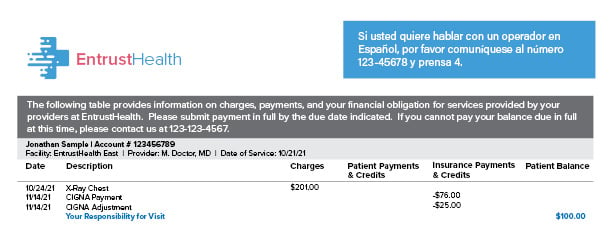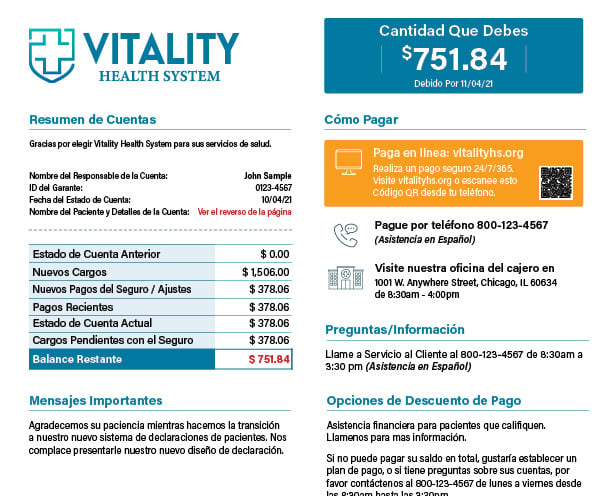Leveraging Patient Statement Translation to Better Serve LEP Patients
March 9, 2022 •Brian Watson


From interacting with staff and providers to understanding financial responsibility and payment options, effective communication is an indispensable part of our healthcare system.
Communication breakdowns at any point in the process can constrain patients’ access to necessary treatment, impair health outcomes, limit financial choices, and reduce satisfaction with their care.
Overcoming those barriers is even more important for Limited English Proficiency (LEP) patients – individuals who don’t speak English as their primary language or have a limited ability to read, speak, write, or understand English.
Because LEP patients are often at greater risk of being misinformed about their care, receiving the wrong type of care, or obtaining no care, language assistance is often justifiably focused on intake and treatment. But the same language access and comprehension issues that cause problems during treatment are also a challenge for the financial side of healthcare.
When it comes to financial engagement, the need is clear. Patients that don’t fully understand their financial responsibilities or options are more likely to have a negative, adversarial view of the fiscal side of care – and are less apt to pay promptly or seek out financial tools and resources that help smooth the payment process.
LEP and Your Patient Population
According to reports from the U.S. Census Bureau, about 8% of the U.S. population over the age of five is estimated to speak English at a level less than "very well".
On the surface, that might not sound like a significant percentage of the population.
But consider it another way: if your patient base mirrors the U.S. at large, nearly one-in-ten could struggle to read and understand your financial correspondence. That could have all sort of negative consequences – from harming patient experience to increasing days in A/R.
It’s also potentially a matter of regulatory scrutiny. The Department of Health and Human Services (HHS) requires all intities that recieve federal financial assistance from HHS or are covered by civil rights authorities enforced by HHS to provide “meaningful” access to all Limited English Proficiency (LEP) patients.
Although the regulations described in Title VI of the Civil Rights Act of 1964 and Section 1557 of the Affordable Care Act don’t require the translation of every patient-facing document, HHS does recommend that providers take reasonable steps to ensure access to language assistance services. Compliance with these guidelines is monitored by the HHS Office for Civil Rights (OCR).
Put simply, it’s important that your financial engagement is designed with the needs of LEP patients in mind. Like all good patient communication, it should be relevant, targeted, and easy to understand and use. Let’s take a look at some quick translation steps you can take to help your organization get there.
Step 1: Understand the Language Preferences of Your Patients
In the U.S., English fluency varies greatly by geographic area.
A review of county-level English proficiency data from the 2020 U.S. Census shows many areas where over 99% of a local population speaks English “very well”. Providers serving these areas might find ESL billing inserts or targeted, on-statement customer support messages are an effective way to serve the needs of non-English speaking patients
Other regions are on the opposite end of the spectrum – including some counties where nearly 50% of residents are estimated to speak English at a level less than proficiently. These are populations that would likely be best served by full statement translation or pre-billing engagement.
It’s crucial to understand the audience you need to reach and their language needs prior to determining translation goals. That means establishing which languages will be supported and the specific materials that need to be developed or translated.
To get a better idea of exactly who you’re serving and what sort of resources will be needed to establish an effective translation program, start by tapping into available sources of language data.
- Review field-level data about which languages your patient populations are fluent in. The U.S. Census Bureau website provides detailed information about household language usage and English proficiency collected during the 2020 Census. Results are filterable by state, county, MSA, and zip code, providing a granular snapshot of Limited English Proficiency (LEP) households and language use for specific regions.
- Leverage the language preference data your organization collects at intake – through chart codes/notes or via a data field for language code in a practice management system. Collected directly from patients, internal data is generally the most relevant, actionable data source available for developing translation strategy.
Step 2: Develop Your LEP Engagement Strategy
Once you’ve developed a list of languages to support, it’s time to consider the best way for your organization to adopt an effective translation strategy for patient financial engagement.
Ideally, your strategy should pivot to fit the research uncovered in step one. Based upon the English proficiency and language preferences of your patient population, financial engagement may include statement inserts, targeted translation, full statement translation, or a mix of these options.
- Multi-Lingual Statement Inserts
Multi-lingual inserts are typically used to provide targeted support information and instructions to patients in a variety of languages – from a single document. They’re especially useful if a patient population is mostly English proficient and secondary language preferences aren’t confined to one or two prevailing dialects. Providers that lack the ability to record patient language preferences at intake or leverage that data when creating statement output can also benefit from the use of inserts.
- Targeted Translation
Providing patients with language-specific messaging – like customer support or payment options – within an English-language statement is an example of targeted translation. The LEP engagement approach used by most providers, targeted translation is a good solution for organizations serving a patient base that’s mostly English proficient and has a clear secondary language preference. It’s also commonly used when patient language preference data is not available – preventing full statement translation.

- Full Statement Translation
Just like it sounds, full statement translation is used to convert an entire English-language billing statement to one or several supplementary languages. Providing an entire billing document in the patient’s preferred language – messaging, payment options, support info – is the best way to reduce potential language barriers and accelerate payment for LEP patients. One caveat: patient language preferences must be recorded at intake and available in your statement file to trigger variable translation.

- A Mix & Match Approach
Mixing and matching the options above can help eliminate communication gaps that threaten effective engagement. For example, a practice with a large Spanish-speaking population might use targeted translation in Spanish, while also providing an insert with instructions in other commonly observed languages – like Russian, Vietnamese, and Chinese.
Step 3: Translating Your Patient Financial Correspondence
Once your language translation plan has been formalized, the next step is to translate your documentation into selected languages. The following are the two most common options for translation.
- AI-Enabled Translation Tools
Machine-translation tools, like Google Translate and DeepL, are a good starting point for language translation. Compared to just a few years ago, AI-enabled translators are much better at converting languages without syntax issues or word-usage errors. They also tend to be low- or no-cost and easy to access for anyone with a web browser. No matter how advanced though, the 80/20 rule still applies – language is contextual and complex, and a portion of any translation will likely need fine-tuning. For that reason, consider having a native speaker edit the translation for accuracy.
- Translation Services
Professional translation services are the gold standard for accuracy and clarity – even ensuring that text is written at an appropriate reading level. Visit the American Translators Association for more information about the language translation process and to locate a qualified specialist.
The Wrap-Up
Nearly one fourth of Americans speak a language other than English at home, according to U.S. Census Bureau estimates. Those patients – like all patients – deserve a healthcare experience that’s relevant, personalized, and effective.
To make that happen, it’s critical that your financial engagement consistently meets the language needs of LEP patients. That means understanding the language preferences and needs of your patient population. Building a smart, responsive, useful LEP engagement strategy from the ground-up. And then finally nailing the translation piece with accurate, jargon-free language use.
If you’re unsure on where to start the LEP translation process and need hands-on support from a knowledgeable source, consider touching base with your statement print and mail vendor of choice. At Elite, for example, we’ve presided over many LEP translation projects – and lean on that hard-won experience to help providers better and more efficiently navigate the process. To learn more about how we handle LEP translation – or the patient financial engagement process as a whole – please take a minute to drop us a line.
Get Updates
Featured Articles
Categories
- Charity Care Management (1)
- Compliance (2)
- Customer Service (8)
- Digital Front Door (1)
- Direct Mail (6)
- eBilling (1)
- EBPP (34)
- ESL Statement (2)
- eStatement (1)
- Healthcare Channel Partner Billing (1)
- IVR (3)
- Mobile Payment (11)
- Online Billing and Payment (6)
- Online Patient Payment (17)
- Outsource Print Management (4)
- Paperless Billing (4)
- Patient Engagement (2)
- Patient Friendly Billing (21)
- Print and Mail (7)
- QR Codes (1)
- Quick Pay (7)
- Security (1)
- Self-Pay Patients (9)
- Self-Pay Revenue (4)
- Statement Design (32)
- Statement Print and Mail (1)
- Statement Printing and Mailing (28)
- Statement Processing (36)
- TransPromo (1)
- Up-Front Billing (1)

